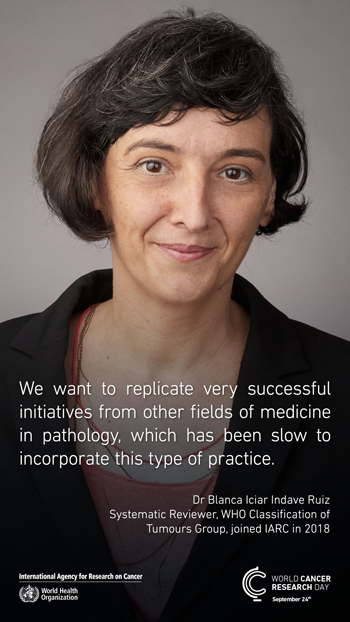❝We want to replicate very successful initiatives from other fields of medicine in pathology, which has been slow to incorporate this type of practice.❞
Please introduce yourself. How long have you worked at IARC, and where did you work before?
I’m Iciar Indave, the systematic reviewer of the WHO Classification of Tumours Group, and I have been at IARC for almost two years. I am a medical doctor, with a specialty in public health, and I am dedicated to the promotion of evidence-based practice. I am a systematic reviewer, which means that I assist in conducting systematic reviews and explore how using systematic processes can minimize bias when gathering and summarizing evidence to inform decision-making. Before coming to IARC, I lived in Germany, Cuba, Spain, and Portugal, and I worked at the National Centre of Epidemiology in Madrid, Spain, as an epidemiologist in the Behaviour and Health Unit.
What are the most interesting projects you are currently involved in, and why are they important?
I’m currently involved in two big, interrelated projects. I’m coordinating the International Collaboration for Cancer Classification and Research (IC3R), which constitutes a unique forum for evidence generation, standard setting, and best practice recommendations for tumour classification and cancer research. Within that setting, I am starting one of the main projects of IC3R, the Evidence-Based Pathology Project, which is dedicated to bringing evidence-based medicine into the pathology field and building up a hub of systematic reviewers. We want to replicate very successful initiatives from other fields of medicine in pathology, which has been slow to incorporate this type of practice. Pathologists are doctors who specialize in interpreting laboratory tests and evaluating cells, tissues, and organs to diagnose cancer types and stages. The goal of this project is to translate research into better information for doctors and more accurate diagnostics for patients.
What do you do when you’re not doing research at IARC?
I play around with Ana, my four-year-old daughter. I am a science fiction (SF) fan and often read SF books and watch SF movies. For the past two years, I’ve been taking French lessons too! Since coming to IARC, I’ve started a healthier lifestyle with regular exercise.
Why did you move into research?
I had eight years of clinical experience as a medical doctor and was very frustrated by my limitations in understanding research, and the lack of help I found translating research findings into practice. Therefore, when I started to feel a bit burned out, I decided to specialize in public health, study epidemiology, and finally dedicate myself to systematic reviews.
Which personal scientific contribution are you most proud of?
I’m very proud of my contribution to a systematic review titled “Mortality risk during and after opioid substitution treatment: systematic review and meta-analysis of cohort studies”, which had a high impact in the field, and of my scientific contribution to the Joint Action on HIV and Co-infection Prevention and Harm Reduction (Joint Action HA-REACT). However, my current project on evidence-based pathology has the potential to be a once-in-a-lifetime experience, and I’m very passionate about it.
What is something you do now because of research you’ve read?
While I was doing my research, I learned about the existence of different bad practices, and one of the most surprising is a practice that is sometimes called “stealth research”. This refers to aggressive biomedical innovation development happening outside the peer‐reviewed literature that makes it into the “real world” of health-care practice without evidence to support it. This type of example motivates me to keep contributing to evidence-based practice.

